Rhodolite Stone: Uncovering Its Beauty and Benefits
In this Article:
Introduction to Rhodolite Stone
The Origin of Rhodolite
Colours and Varieties of Rhodolite
Geological Formation of Rhodolite
Mineral Composition
Formation Process
Properties of Rhodolite
Physical Properties
Metaphysical Properties
Uses and Applications
Jewellery
Healing and Meditation
How to Care for Rhodolite Jewellery
Cleaning Techniques
Storage Tips
Conclusion
FAQs
Introduction to Rhodolite Stone
The Origin of Rhodolite
Rhodolite is a variety of the mineral pyrope, a member of the garnet family. It was first discovered in the late 19th century in North Carolina, USA. The name "Rhodolite" originates from the Greek word "rhodon," which means "rose-like," referring to its stunning rose-red colour.
Colours and Varieties of Rhodolite
Rhodolite stones are known for their captivating shades of red and purple. They typically range from a raspberry red to a purplish-red hue, with some stones displaying hints of orange or pink. The colour intensity and hue may vary depending on the source and specific mineral composition.
Geological Formation of Rhodolite
Mineral Composition
As a pyrope garnet variety, rhodolite is primarily composed of magnesium aluminum silicate. Its unique colour results from the presence of iron and chromium, which cause the red and purple hues, respectively.
Formation Process
Rhodolite garnets form under high pressure and temperature conditions deep within the Earth's crust. They are commonly found in metamorphic rocks, such as schist and gneiss, as well as in igneous rocks like granite and volcanic deposits.
Properties of Rhodolite
Physical Properties
Rhodolite is a durable gemstone, with a hardness of 7 to 7.5 on the Mohs scale. This makes it suitable for everyday wear and various types of jewellery. It has a vitreous luster and exhibits excellent transparency, contributing to its popularity among gemstone enthusiasts.
Metaphysical Properties
Many people believe that rhodolite garnet possesses powerful metaphysical properties. It is said to enhance emotional balance, self-confidence, and creativity. Some also claim that it can help in strengthening relationships, fostering compassion, and promoting spiritual growth.
Uses and Applications
Jewellery
Due to its durability, brilliant colour, and luster, rhodolite is an ideal choice for jewellery pieces such as rings, earrings, necklaces, and bracelets. It is often used as a more affordable alternative to ruby or sapphire, without compromising on beauty and elegance.
Healing and Meditation
In addition to its aesthetic appeal, many people use rhodolite for its healing properties. It is believed to promote emotional healing, balance energy, and enhance meditation practices. Crystal healers often incorporate rhodolite stones into their sessions to help clients overcome emotional trauma and improve overall well-being.
How to Care for Rhodolite Jewellery
Cleaning Techniques
To maintain the beauty of rhodolite jewellery, regular cleaning is essential. It is recommended to clean rhodolite using a soft, lint-free cloth and warm, soapy water. Gently scrub the stone with a soft toothbrush to remove any dirt or grime. Avoid using harsh chemicals, steam cleaners, or ultrasonic devices, as these may damage the gemstone.
Storage Tips
Proper storage is vital for preserving the condition of your rhodolite jewellery. When not in use, store each piece separately in a soft pouch or a lined jewellery box to prevent scratches and other damages. Keep your rhodolite jewellery away from direct sunlight and high temperatures, as prolonged exposure may cause the colour to fade.
Conclusion
Rhodolite garnet is a captivating gemstone that offers a stunning blend of red and purple hues. Its beauty, durability, and unique properties make it an ideal choice for jewellery and metaphysical applications. With proper care and maintenance, rhodolite can remain a treasured addition to any gemstone collection for years to come.
FAQs
What is the difference between rhodolite and other types of garnets?
Rhodolite is a variety of pyrope garnet, distinguished by its unique raspberry red to purplish-red colour. Other garnet varieties include almandine, spessartine, grossular, and uvarovite, each with its own distinct colour and properties.
2. Where can rhodolite be found?
Rhodolite garnets can be found in various locations around the world, including the United States, Brazil, India, Madagascar, Mozambique, Sri Lanka, and Tanzania.
3. Is rhodolite suitable for engagement rings?
Yes, due to its hardness and durability, rhodolite is a popular choice for engagement rings. Its unique colour and affordability make it an attractive alternative to more expensive gemstones like rubies or sapphires.
4. How can I determine the quality of a rhodolite gemstone?
The quality of a rhodolite gemstone is determined by factors such as colour, clarity, cut, and carat weight. Look for stones with a vibrant, saturated colour, excellent transparency, and a well-proportioned cut that maximizes light return.
5. Do rhodolite garnets have any special care requirements?
While rhodolite is a durable gemstone, it's important to clean and store it properly to maintain its beauty. Clean rhodolite with warm, soapy water and a soft toothbrush, and store it separately in a soft pouch or lined jewellery box to prevent scratches. Avoid exposing it to harsh chemicals or extreme temperatures.





